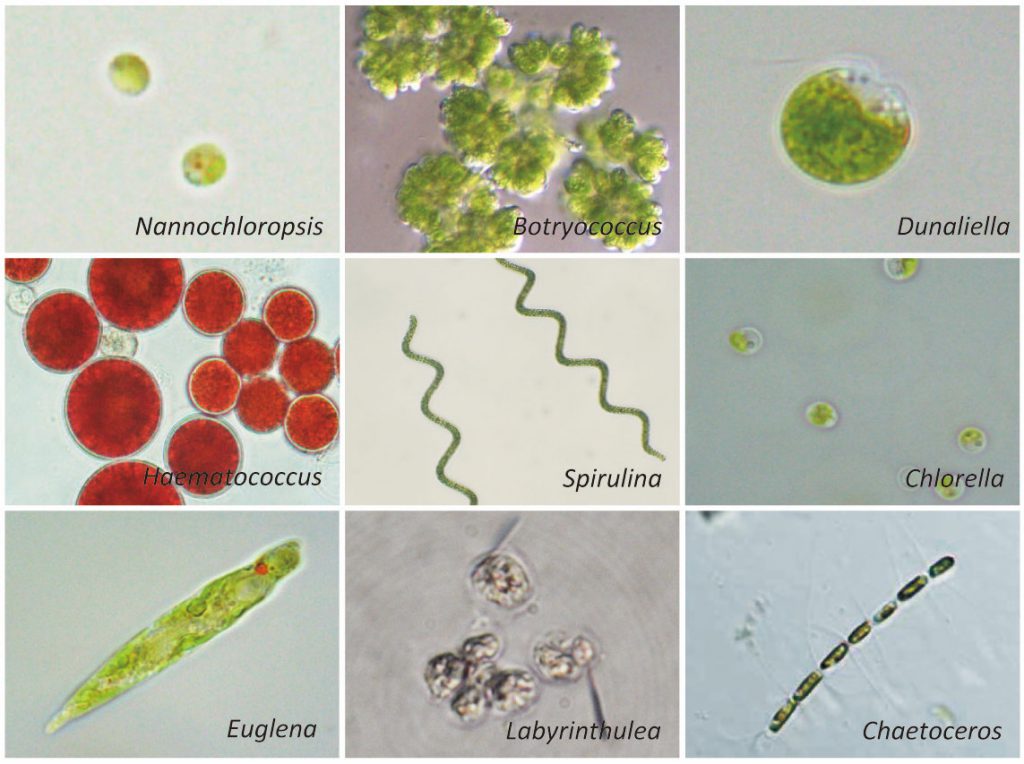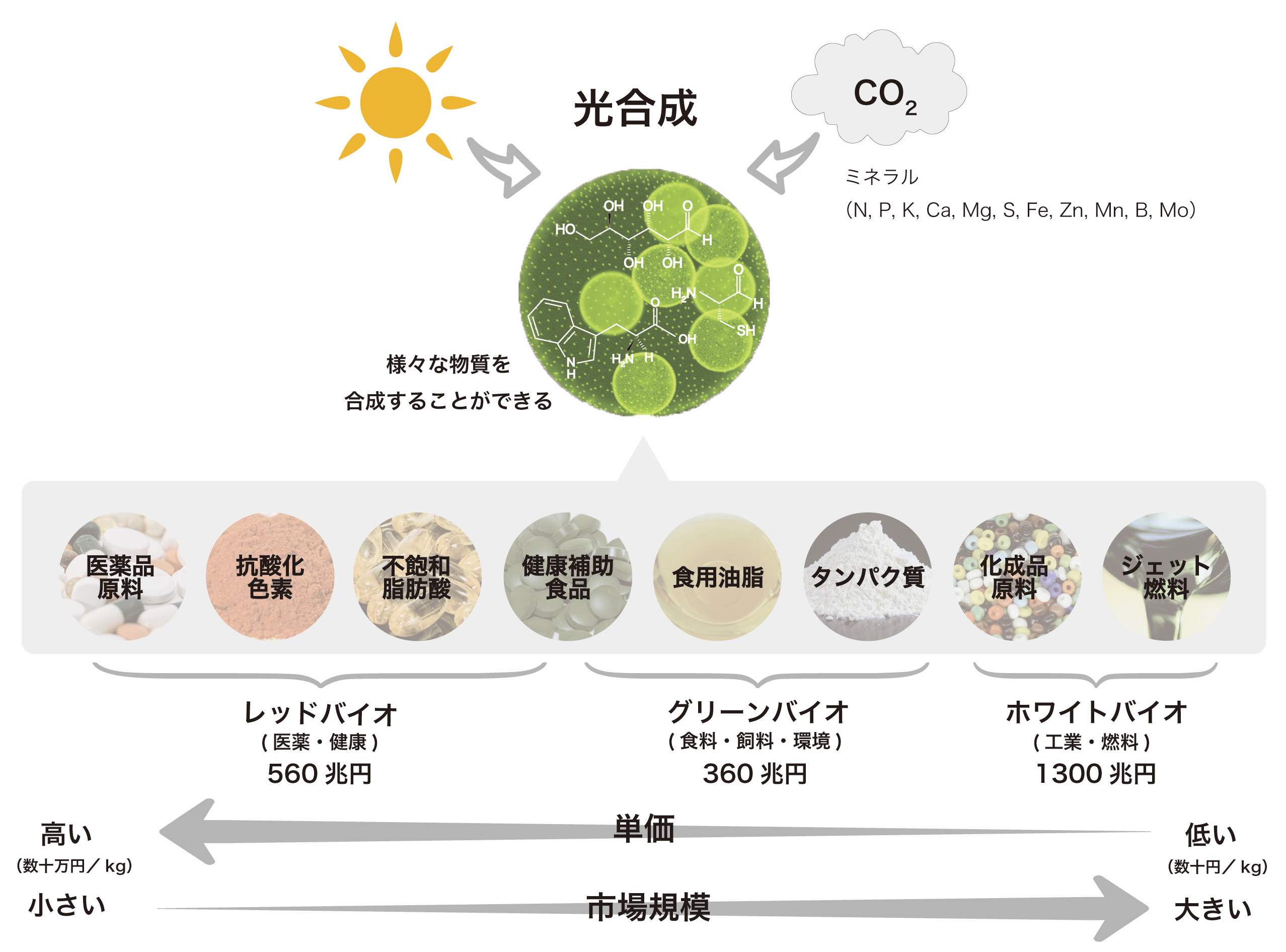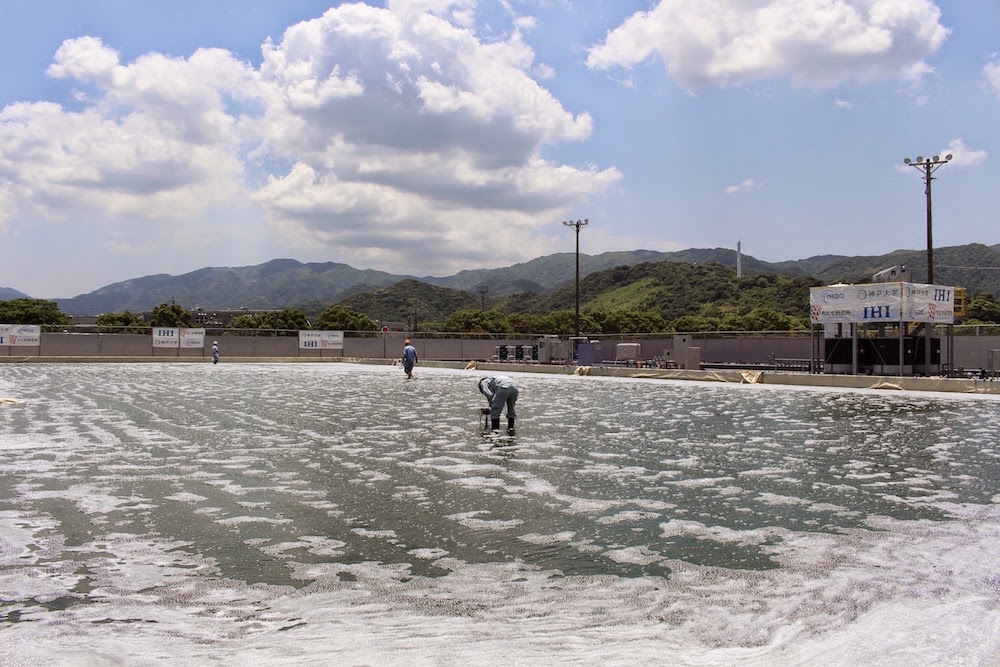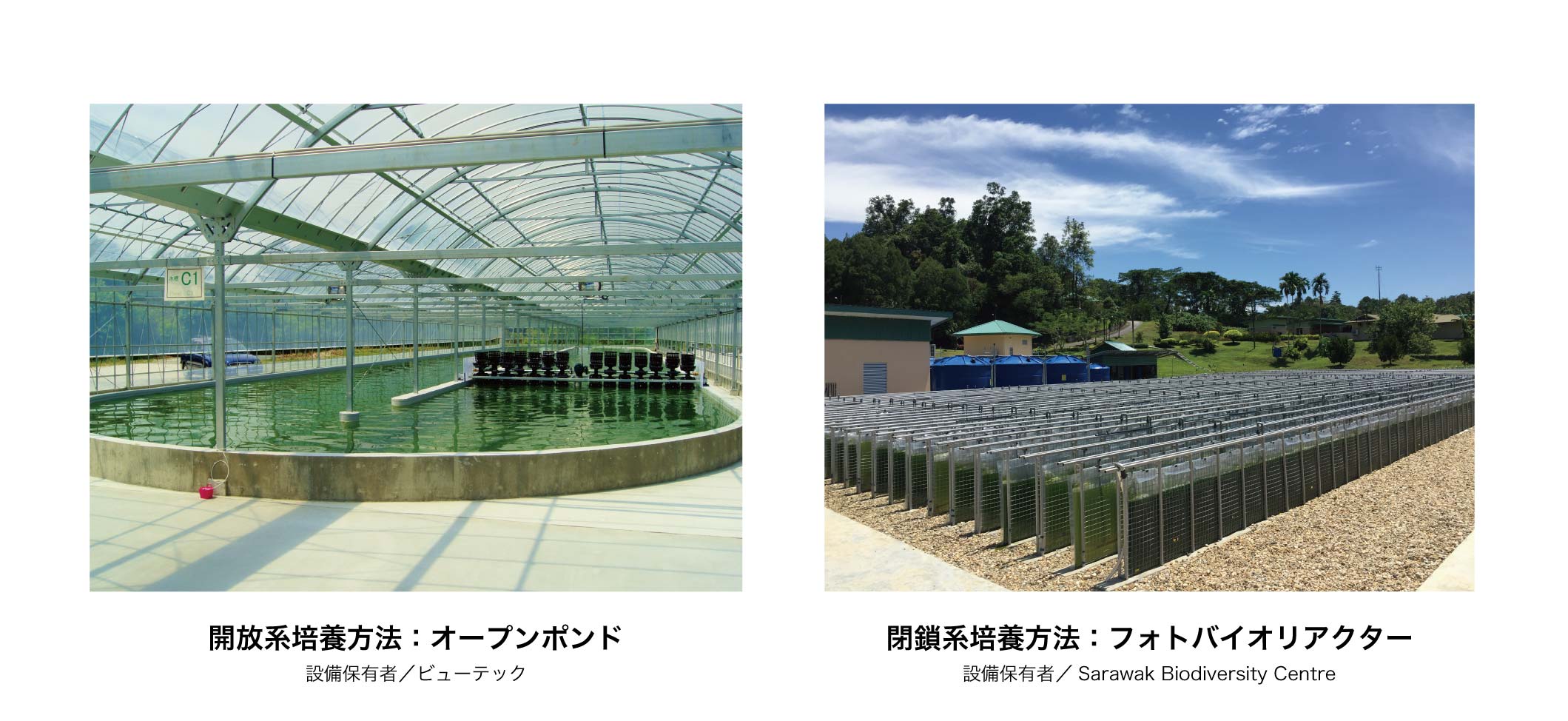3.5 billion years ago, algae created a reaction called "photosynthesis", created the atmosphere, exterminated many living things, and then created them again. Even in today's world of rapid technological progress, human beings are nothing more than a single piece in the global ecosystem created by algae, and that fact will never change.
We live in an era where it is difficult to see what is the correct answer as our lives have become richer and various values have emerged. I think so.
On this page, I would like to tell you about the charm of algae as a living thing while unraveling its history. What kind of algae are the bases of biofuel (SAF/fuel), which has recently become a hot topic?
What are algae?

"Algae", but do you know what kind of creature it is?
In terms of familiarity, think of the green water that you often see in ponds and paddy fields. In that green water there is a wide variety of tiny green creatures that are invisible to the naked eye. On this site, we call these mainly green creatures, less than 1 mm in length, "algae (*) " in the water.

Representative algae in commercial use ©2017 Chitose Laboratory
* Strictly speaking biologically, the category of "algae" includes seaweeds such as wakame seaweed and kelp, as well as protozoa that do not perform photosynthesis, but when referring to them, we use different words to describe them. doing. The word "algae" in this column refers to "microalgae" unless otherwise specified.
Relationship between algae and humans
Algae are sometimes called "small plants" because they perform photosynthesis like plants, but in fact, algae are the ancestors of plants in the process of evolution.
Both food and fossil fuels can be traced back to algae
The origin of algae dates back to about 3.5 billion years ago . It is said that the earth was born 4.6 billion years ago, and the present human beings (Homo sapiens) were born 200,000 years ago, so you can see how old algae are. .
Algae have evolved in water and landed on land about 500 million years ago. After passing through moss and fern plants, they have evolved into the plants that surround us today. It is said that in the process of evolution from algae to plants, the remnants of a large amount of biomass (*) were deposited in the ground and converted into fossil resources over a long period of time. In other words , modern humans live by digging up the accumulation of evolution from algae to plants and using it as an energy source and raw material for chemical products .
In addition, modern plants are the descendants of algae, and humans live on a daily basis by directly or indirectly eating these plants as agricultural crops.
 ©2017 Chitose Laboratory
©2017 Chitose Laboratory
In this way, it is no exaggeration to say that the existence of algae is the basis of modern human life, and it is no exaggeration to say that algae support the foundation of human life . What's even more surprising is that algae are still thriving on the earth in the same way as they were in ancient times.
*Biomass is a general term for things that can be used as an energy source, such as animals and plants themselves and their byproducts.
Industrial potential of algae
Now that you have understood the relationship between humans and algae, I would like to explain the potential of algae as an industry.
Algae can be used in various industrial fields
Like plants, algae grow through photosynthesis . Photosynthesis is literally a reaction that uses the energy of light to synthesize various substances. The main raw material for photosynthesis is carbon dioxide (CO 2 ), and other inorganic substances such as nitrogen, phosphorus, potassium, and minerals are taken in to synthesize complex compounds.
Since various compounds synthesized by photosynthesis can be used as raw materials for various industries, algae can be deployed in various industrial fields.
 ©2017 Chitose Laboratory
©2017 Chitose Laboratory
The compounds that can be synthesized by algae can be divided into three major fields by sorting them by market size and unit price and arranging them in order. In the bio industry, these three fields are expressed as follows by comparing them to colors.
● “Red Bio” (high unit price / small market):
Fields related to pharmaceuticals and health, mainly raw materials for pharmaceuticals and functional materials
● “Green Bio” (medium unit price / on the market):
Fields related to food such as food and feed
● “White Bio” (low price / large market):
Fields related to energy and chemistry, such as fuels and raw materials for chemical products
These three fields are among the top three existing industrial fields in terms of market size, with a combined total of 2,000 trillion yen . Algae can be said to be a potential industrial seed that can be developed into a market of this scale .
Why are algae attracting attention now?
Algae have such high industrial potential, but why is it now attracting attention again?
Expectations for algae are closely related to the historical background
Due to its biological characteristics, algae have the property of attracting attention when the foundation of human survival is destabilized, such as the "food crisis" or the "energy crisis." It came into the spotlight during the oil crisis. In other words, it is closely related to the historical background.
The characteristics of algae are as follows.
<Characteristics of algae>
 ©2017 Chitose Laboratory
©2017 Chitose Laboratory
①It can fix carbon dioxide (CO 2 )
→ Through photosynthesis, CO 2 can be absorbed and materialized. For this reason, culturing algae leads to suppressing increases in CO 2 concentration, which is said to be one of the causes of global warming.
(2) Effective utilization of water resources
→ Algae tends to be imaged as using a large amount of water, but it can be cultivated using much less water resources than agriculture. In agriculture, most of the water sprayed on the fields evaporates or seeps into the ground, whereas with algae, only the amount that evaporates from the surface of the water. In addition, seawater can be used for marine algae, eliminating the need to use freshwater resources that are feared to be depleted.
③ Can be used on any land
→Algae can be cultivated basically anywhere as long as there is water and light. For this reason, it is possible to make effective use of land that is currently underutilized because no plants grow, such as deserts and wastelands. This means that farming and living can be separated. In fact, most of the algae that are currently in practical use use land that cannot be used for farming.
④Extremely high productivity
→ There is almost no difference in the mechanism and efficiency of photosynthesis between plants and algae. However, in plants, a large amount of energy must be devoted to maintaining the non-fruiting parts such as roots, stems, and leaves, whereas in algae, the fruiting part itself increases, so there are many parts that can be utilized by humans. This results in significantly higher productivity compared to plants.
Modern society is facing common global issues such as "increase in world population" and "global climate change", and these issues are directly linked to human survival risks such as "food crisis" and "energy crisis". It can be said that
The fact that the issue is global means that if a global emergency were to occur tomorrow, there is a high possibility that we would be involved in its impact. The vague fears and anxieties within each individual that the food and energy crises are not someone else's problem will likely continue to grow as globalization progresses. Unlike wars and oil crises, which are temporary and localized, today's challenges are characterized by being constant and global .
Mass production of algae, which can be used for both food and energy, is one of the moves to reduce these concerns. He analyzes that the reason why algae are attracting attention in the present age is that there is a vague fear and anxiety about the basis of human survival linked to this historical background.
Inexpensive mass culture technology essential for industrialization
Currently, research and development of algae is underway in various countries, but the most necessary development for algae to grow as an industry is "low-cost mass cultivation technology" .
 In 2015, a large-scale outdoor demonstration of biofuel-use microalgae (Botryococcus) was made public as part of the "Strategic Next-Generation Biomass Energy Utilization Technology Development Project" commissioned by the New Energy and Industrial Technology Development Organization (NEDO). State of cultivation
In 2015, a large-scale outdoor demonstration of biofuel-use microalgae (Botryococcus) was made public as part of the "Strategic Next-Generation Biomass Energy Utilization Technology Development Project" commissioned by the New Energy and Industrial Technology Development Organization (NEDO). State of cultivationAt present, the algae species called Spirulina are the most produced algae in the world, but the total annual production of Spirulina is only about tens of thousands of tons. This is insignificant compared to the world production of cereals (rice, corn, wheat, barley, etc.) of about 2.5 billion tons (FAO: 2016).
This difference in production volume is thought to be due to the large historical difference between agriculture, which began 15,000 years ago and has continued to improve, and algae, which was only successfully mass-cultured for the first time 50 years ago. The development of technology for cultivating algae in large quantities at low cost is still in its infancy, and researchers around the world are proceeding with the development of various types of culturing methods through trial and error.
There are two types of algae mass cultivation methods that are currently mainstream.
Current algae mass culture methods can be broadly divided into two types: the open system culture method using a pond [open pond] and the closed system culture method using a bioreactor [photobioreactor (PBR)]. increase. The former is a cultivation method using shallow ponds established 50 years ago, in which algae are cultivated while stirring the water with a water wheel or air. The latter is a method that has been developed in recent years, and is a method of culturing algae three-dimensionally using tubes, films, membranes, etc.
 ©2021 Chitose Laboratory
©2021 Chitose Laboratory
What is the definitive version of algae culture?
Just as there are various farming methods for each crop in agriculture, the optimal cultivation method for algae differs depending on various conditions such as the species to be cultivated, the region, the climate, and the shape of the land. For this reason, there is no universal culture method that is the definitive algae culture method. Researchers around the world are trying to find the best way to grow algae at low cost, while considering the optimal cultivation method for each condition.
The future of the algae industry
With the advent of agriculture 15,000 years ago, mankind has become able to secure a stable food supply. I stopped chasing food and switched to a growing method. In that sense, it can be said that agriculture has caused a great change in human civilization.
As a means of food production alongside agriculture
While agriculture is a production system that uses soil and plants, algae is a production system that uses water and microorganisms. Until now, humans had only had agriculture as a means of producing food, but we have gained another new production means using algae.
In other words, a new production system comparable to agriculture, which has greatly changed human civilization, is being born today . I think it is a revolutionary event that is called "Algae-culture" .
Photosynthesis is the only way to produce organic matter from the sun and carbon dioxide, and until now we have benefited from this through agriculture, but from now on we are beginning to see the option of receiving it through algae as well. In addition, it is possible to live separately from agriculture by using land and water resources (seawater) that cannot be used for agriculture.
Agriculture on land that can be used for agriculture, algae industry on land that cannot be used for agriculture. From there, we will create a new industrial ecosystem for a market with a scale of 2,000 trillion yen.This is the future of the algae industry that we see.
 ©2017 Chitose Laboratory
©2017 Chitose Laboratory
Japan can lead the algae industry
As an agrarian people, we have an ingrained agricultural sensibility, technology to handle microorganisms nurtured in a fermentation culture, and scientific knowledge that we have taken in and developed from the West. In addition, the high tolerance of algae to people based on the food culture of eating seaweed. Japan has all the essential elements to create an algae industry. I hope that as many people as possible will be interested in algae, and Japan will take the lead in developing it into an industry that will be passed on to future generations.
If MATSURI establishes the concept of the "algae industry" through the construction of the algae industry and makes it a work that will remain in the world history of the future, there is nothing more.
Modia reference link: https://modia.chitose-bio.com/what_is_the_charm_of_algae/




